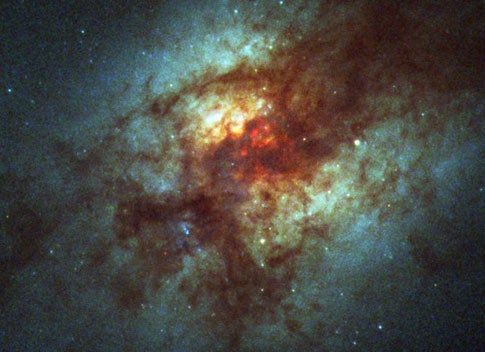Astronomers announced Tuesday, January 9, the first direct discovery of magnetic fields in galaxies other than the Milky Way. Timothy Robishaw, Carl Heiles, and Eliot Quataert of the University of California at Berkeley presented their research at the American Astronomical Society meeting in Seattle, Washington. The result provides the first direct measurement of strong magnetic fields in other galaxies.
Robishaw, Heiles, and Quataert were looking for the signature of magnetic fields in extremely bright laser light being emitted from galaxies known as Ultraluminous Infrared Galaxies, or ULIRGs (pronounced yoo-lurgs). “The ULIRGs are extremely bright when seen at infrared wavelengths,” said Robishaw, “which means that these galaxies are pumping out a tremendous amount of heat.” This heat is generated by either many young stars being born in the center of the galaxy or by the accretion of matter onto a central black hole. According to Quataert, “It is still something of a mystery as to whether stars or black holes produce most of the heat in ULIRGs.”
“One side effect of the heat generated in ULIRGs is that the gas around young stars can emit laser light,” explained Robishaw. This laser light is actually produced at microwave (or radio) wavelengths, and therefore these lasers are known as masers. Our own Milky Way galaxy is littered with masers that surround regions of star formation. “But the microwave lasers we looked for weren’t as wimpy as the kind we find here in our Galaxy,” said Heiles. “These masers are brighter than ten thousand Suns. They’re so intense they’re known as megamasers!”
As part of his Ph.D. research, Robishaw has been using the biggest telescopes on Earth to measure magnetic fields in the Milky Way using a method known as the Zeeman effect. The signature of this effect is observed as the splitting of a radio frequency line: the larger the splitting, the larger the magnetic field that is being probed. Robishaw suggests the following analogy: “When you scan the radio dial and you tune in the same station separated by a small blank space, the size of that blank space would be directly proportional to the strength of the magnetic field at the location in space where the signal is being broadcast.” This same effect is the principle on which MRIs are based.
While studying the possible strength of magnetic fields in ULIRGs, Quataert asked Robishaw and Heiles whether they had looked for magnetic fields in these galaxies. “Not only had we not looked for magnetic fields in ULIRGs,” explained Robishaw, “I had to look up what a ULIRG is!” Not long after this, Robishaw and Heiles saw a talk by Dr. Jeremy Darling of the University of Colorado at Boulder in which Darling presented his Ph.D. thesis work on megamaser emission from interstellar hydroxyl (OH) molecules in ULIRGs. Robishaw and Heiles were intrigued about the possibility of looking for the Zeeman effect in these OH megamasers since less bright masers are often used here in our own Milky Way galaxy to probe magnetic fields. “While reading Jeremy’s thesis we learned that all of these OH megamasers are found in ULIRGs,” said Robishaw. “So we went back to Eliot and put together a proposal to observe a sample of ULIRGs with the brightest megamasers.”
The team used the National Science Foundation’s Arecibo Observatory to observe six galaxies including Arp 220, the archetypal ULIRG. At 305 meters (1,000 feet) in diameter, Arecibo is the largest single telescope on Earth with a collecting area of over 18 acres. The team discovered magnetic fields in four of the six galaxies and found fields in a total of 16 megamasers. “This is an amazing discovery because until now there has been only one direct detection of an extragalactic magnetic field,” said Heiles, “and that was in a gas cloud surrounding another galaxy, rather than in the galaxy proper.” The magnetic field strengths found via megamasers in ULIRGs are similar to those found in regions where such masers occur in our own Galaxy. According to Quataert, “This similarity suggests that the megamasers are also associated with regions where young stars are being born (rather than black holes) and that the process of how these stars form in other galaxies is similar to how they form in our own Galaxy — a point that has been much debated by astronomers.”
The team has already extended its survey by observing 7 more galaxies using the National Science Foundation’s 100 meter (300 feet) Green Bank Telescope in West Virginia and will return to Puerto Rico to observe 6 more galaxies early this year. In addition, they plan to simultaneously use dozens of large radio telescopes spread across the Earth in an attempt to pinpoint the exact locations of the magnetic fields in the center of Arp 220.










